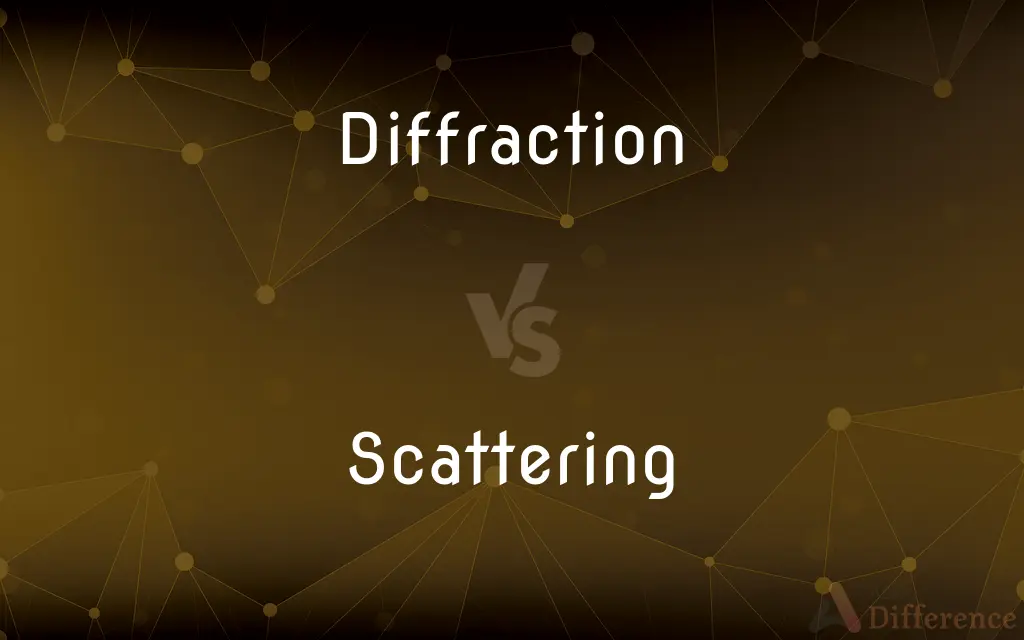Diffraction vs. Scattering — What's the Difference?
By Tayyaba Rehman & Urooj Arif — Updated on March 11, 2024
Diffraction occurs when waves encounter obstacles, bending around them, while scattering involves waves being forced in different directions by particles.

Difference Between Diffraction and Scattering
Table of Contents
ADVERTISEMENT
Key Differences
Diffraction involves the bending and spreading out of waves, such as light or sound, when they encounter an obstacle or a slit that is comparable in size to their wavelength. This phenomenon can result in various patterns of constructive and destructive interference, often observed as a series of light and dark bands or fringes. On the other hand, scattering is the process by which waves or particles are forced to deviate from a straight trajectory due to irregularities in the medium through which they are traveling or when they encounter small particles. Scattering is responsible for phenomena such as the blue color of the sky, which results from the scattering of sunlight by the atmosphere's molecules.
While diffraction patterns are highly dependent on the wavelength of the waves and the geometry of the obstacle or aperture, scattering patterns can vary greatly depending on the size, shape, and material of the particles causing the scattering. Diffraction is often observed in a controlled environment where the obstacles or apertures have well-defined shapes and sizes, whereas scattering can occur in a wide range of natural and experimental settings.
In diffraction, the direction and intensity of the diffracted waves are predictable based on the wave properties and the object's characteristics. However, in scattering, the direction and intensity of the scattered waves can be more complex and harder to predict, especially in cases of multiple scattering where waves are scattered by many particles.
Diffraction is particularly important in the study and application of wave phenomena, including optics, acoustics, and quantum mechanics. It is essential for understanding the behavior of waves in various situations and is exploited in technologies such as diffraction gratings and holography. Scattering, on the other hand, is crucial in fields such as astronomy, atmospheric science, and materials science, providing valuable information about the properties of celestial bodies, atmospheric composition, and the structure of materials.
The observation and analysis of diffraction and scattering provide complementary insights into the nature of waves and their interactions with matter. While diffraction reveals the wave-like properties of particles and helps in understanding the wave behavior in constrained environments, scattering offers insights into the interactions between waves and particles, contributing to our understanding of particle sizes, structures, and the nature of their interactions.
ADVERTISEMENT
Comparison Chart
Definition
The bending of waves around obstacles or through apertures.
The redirection of waves in various directions by particles.
Dependency
Depends on the wavelength and obstacle or aperture size.
Depends on the size, shape, and material of the particles.
Predictability
More predictable patterns (e.g., fringes).
Less predictable, can be random depending on the interaction.
Key Phenomena
Interference patterns, light and dark bands.
Blue sky, rainbow formation.
Importance in
Optics, acoustics, quantum mechanics.
Astronomy, atmospheric science, materials science.
Compare with Definitions
Diffraction
The process by which a wave bends around the edges of an obstacle or through an aperture.
The diffraction of sunlight through a small aperture creates a pattern of light and dark bands on the surface.
Scattering
The process in which waves or particles are deflected or diffused.
The scattering of sunlight by atmospheric particles is what makes the sky appear blue.
Diffraction
An optical component with a regular pattern that diffracts light into several beams.
Diffraction gratings are used in spectrometers to separate light into its component wavelengths.
Scattering
Scattering of light by particles about the same size as the wavelength of the light.
Mie scattering by atmospheric particles contributes to the white appearance of clouds.
Diffraction
A phenomenon where two or more waves superpose to form a resultant wave of greater, lower, or the same amplitude.
In diffraction, constructive and destructive interference patterns emerge due to the overlapping of diffracted waves.
Scattering
Scattering of light by particles much smaller than the wavelength of the light.
The blue color of the sky is primarily due to Rayleigh scattering by the gases in the atmosphere.
Diffraction
The alternating light and dark bands produced by the interference of diffracted waves.
Observing the fringe pattern allows scientists to determine the wavelength of the light used in the diffraction experiment.
Scattering
The process in which waves scatter multiple times before reaching the observer.
Multiple scattering in dense media like fog or clouds can significantly diffuse light, reducing visibility.
Diffraction
A technique that uses the diffraction of light to create a three-dimensional image of an object.
Holograms are produced by recording the interference pattern between a reference beam and the light diffracted from an object.
Scattering
A form of scattering in which the scattered photon has a different energy than the incident photon.
Raman spectroscopy utilizes Raman scattering to provide information about the vibrational modes of molecules.
Diffraction
Change or dispersion of the direction and intensity of a wave as it traverses an object or aperture, especially when the size of the object or aperture approximates the wavelength of the wave.
Scattering
Scattering is a term used in physics to describe a wide range of physical processes where moving particles or radiation of some form, such as light or sound, are forced to deviate from a straight trajectory by localized non-uniformities (including particles and radiation) in the medium through which they pass. In conventional use, this also includes deviation of reflected radiation from the angle predicted by the law of reflection.
Diffraction
Diffraction refers to various phenomena that occur when a wave encounters an obstacle or opening. It is defined as the bending of waves around the corners of an obstacle or through an aperture into the region of geometrical shadow of the obstacle/aperture.
Scattering
Something scattered, especially a small, irregularly occurring amount or quantity
A scattering of applause.
Diffraction
(physics) The bending of a wave around an obstacle.
Scattering
(Physics) The dispersal of a beam of particles or of radiation into a range of directions as a result of physical interactions.
Diffraction
(quantum mechanics) The breaking up of an electromagnetic wave as it passes a geometric structure (e.g. a slit), followed by reconstruction of the wave by interference.
Scattering
Placed irregularly and far apart; scattered.
Diffraction
The deflection and decomposition of light in passing by the edges of opaque bodies or through narrow slits, causing the appearance of parallel bands or fringes of prismatic colors, as by the action of a grating of fine lines or bars.
Remarked by Grimaldi (1665), and referred by him to a property of light which he called diffraction.
Scattering
A small quantity of something occurring at irregular intervals and dispersed at random points.
There will be a scattering of showers, with heavy rain in places.
Diffraction
When light passes sharp edges or goes through narrow slits the rays are deflected and produce fringes of light and dark bands
Scattering
(elections) The total number of votes awarded to nonmajor or unlisted candidates.
Scattering
(physics) The process whereby a beam of waves or particles is dispersed by collisions or similar interactions.
Scattering
Going or falling in various directions; not united or aggregated; divided among many; as, scattering votes.
Scattering
Act of strewing about; something scattered.
Scattering
The physical process in which particles are deflected haphazardly as a result of collisions
Scattering
A small number dispersed haphazardly;
The first scatterings of green
Scattering
A light shower that falls in some locations and not others nearby
Scattering
Spreading widely or driving off
Scattering
The act of scattering
Scattering
Spreading by diffusion
Common Curiosities
How does wavelength affect diffraction?
The extent of diffraction increases with wavelength; longer wavelengths bend more around obstacles.
Can diffraction occur with all types of waves?
Yes, diffraction can occur with any type of wave, including light, sound, and water waves.
What causes diffraction?
Diffraction is caused by the bending of waves when they encounter obstacles or pass through apertures.
Why is the sky blue?
The sky is blue due to the Rayleigh scattering of shorter (blue) wavelengths of sunlight by the atmosphere.
What is a diffraction grating used for?
A diffraction grating is used to separate light into its component colors or wavelengths.
Can diffraction and scattering occur simultaneously?
Yes, diffraction and scattering can occur simultaneously, especially in complex mediums.
What is an example of scattering in daily life?
The blue color of the sky is a result of Rayleigh scattering of sunlight by atmospheric molecules.
How is scattering related to the color of objects?
The scattering of light by particles on an object's surface can determine its color, depending on the wavelength of light scattered most.
What role does diffraction play in optics?
In optics, diffraction limits the resolution of imaging systems and is exploited in devices like diffraction gratings.
How does the particle size affect scattering?
Particle size affects the scattering pattern; smaller particles scatter light more uniformly, while larger particles cause less uniform scattering.
How does scattering affect visibility?
Scattering can reduce visibility by diffusing light, as seen in fog or heavy rain.
Share Your Discovery

Previous Comparison
Perfect vs. Polish
Next Comparison
Mind vs. BrainAuthor Spotlight
Written by
Tayyaba RehmanTayyaba Rehman is a distinguished writer, currently serving as a primary contributor to askdifference.com. As a researcher in semantics and etymology, Tayyaba's passion for the complexity of languages and their distinctions has found a perfect home on the platform. Tayyaba delves into the intricacies of language, distinguishing between commonly confused words and phrases, thereby providing clarity for readers worldwide.
Co-written by
Urooj ArifUrooj is a skilled content writer at Ask Difference, known for her exceptional ability to simplify complex topics into engaging and informative content. With a passion for research and a flair for clear, concise writing, she consistently delivers articles that resonate with our diverse audience.















































